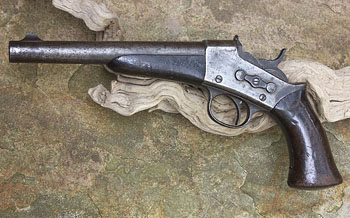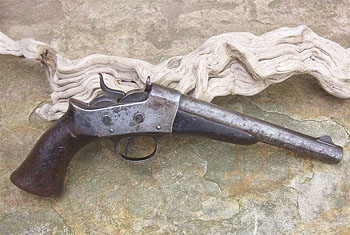 |
||||||||||||||||||||||||||||||
|
The Remington Rolling Block Pistol by Ed Buffaloe
The beauty of the rolling block design was its simplicity, ease of use, and inherent strength. With the hammer cocked, the breech block could be pulled back to allow quick and easy removel and insertion of cartridges. The block was then moved forward to cover the rear of the cartridge. When the trigger was pulled and the hammer fell, a projection beneath the hammer rolled under the breech block, wedging it securely in place. The design was easy to manufacture, and the guns quickly gained a reputation as being safe, reliable, and inherently accurate. The Remington rolling block rifle was a far better weapon than any that had been available during the Civil War. In November of 1866 the U.S. Navy ordered 5000 rolling block pistols in .50 caliber rimfire, and later ordered a small number of centerfire rifles for testing. The rolling block pistols were never very popular because revolvers were much preferred. While U.S. military orders for rifles were quite small, the prestige garnered by Remington for making these sales to the U.S. military captured the attention of military forces all over the world, and Remington sold over a million rolling block rifles to foreign militaries within the first decade of production. The Remington rolling block rifle was the most accurate rifle of its day, though its sales were severely reduced by the advent of the 1873 Winchester, designed by B. Tyler Henry, using the .44-40 centerfire cartridge. But the rapid-fire Winchester couldn’t compete with the single shot Remington rolling block .50 caliber rifle for range and accuracy, and so the Remington became the preferred gun for buffalo hunting and target shooting. In 1873 General George A. Custer participated in an expedition to Yellowstone and took his Remington rolling block rifle. He reported in a letter to Remington that he had shot antelope at measured ranges between 150 and 630 yards with his rolling block rifle, and that it was far and away the most accurate rifle in the expedition as well as the one with the greatest range. The Remington .44-90 buffalo gun, with a 400 grain bullet, was acknowledged to be the best buffalo gun ever made, due to its great accuracy and long range. Because of the simple and reliable rolling block mechanism, it could be fired almost as rapidly as a repeating rifle. It’s only real challenger was the Sharps, but in a famous match held at the Long Island Creedmoor rifle range in 1874 three marksmen shooting Remingtons shot a score of 478 against a 456 shot by three marksmen with Sharps, all using 550 grain bullets in .44-90 cartridges, at ranges of 800, 900, and 1000 yards. A number of different rolling block rifles were manufactured by Remington over the 70 years of rolling block production, and it is beyond the scope of this article to describe them all.
In all, Remington manufactured 5 major models of rolling block pistol, and 2 limited edition target variants, over a period of nearly 50 years. The 1865 Navy pistol. This gun was made with a sheath trigger, an 8.5 inch barrel, and a front bead sight only. It shot the .50 caliber rimfire cartridge. Somewhere between 1000 and 2000 were made. The U.S. Navy purchased at least 500, possibly more. The gun had a simple stud as an extractor, and no firing pin retractor. The 1867 Navy pistol. A trigger guard was added as standard equipment (though the sheath trigger could still be had as a special order). The gun was made in both .50 caliber centerfire and .22 rimfire. The standard barrel length was 7 inches. Karr estimates that over 7000 were made. Schreier states that 6500 were made for the Navy in .50 caliber, but that more were sold on the civilian market. The 1869 Target pistol. A seventeen inch octagonal barrel was fitted to an 1867 Navy receiver, and a skeleton shoulder stock was attached to grooves in the flat buttstock. This was probably the first rolling block pistol to be fitted with an adjustable rear sight. It is not known exactly how many were made, but they are extremely rare. Karr says they were not listed in any catalog. The 1871 Army pistol (sometimes referred to as the Army and Navy Model). This was the final redesign. The trigger and trigger guard were moved forward on the receiver, and a spur was added to the receiver behind the hammer to allow for a better grip. A firing pin retractor was added, and a rotating extractor was designed. The front sight was changed from a bead to a blade, and the lockwork was also redesigned. The gun was available in .50 centerfire, but could be special ordered in .22 rimfire. It was designed for the U.S. military, but was never sold to them. This is the gun pictured above. Karr estimates that over 6000 were manufactured. The 1879 Army pistol. A sixteen inch half-octagon barrel was fitted to an 1871 Army receiver, along with a detachable shoulder stock. Karr speculates that certain army officials may have encouraged the development of this gun. Only a few were ever sold to the public, and apparently there is no record of the army ever purchasing any. They are extremely rare. The 1891 Target pistol. The 1871 gun was given target sights and a 10 inch half-octagon barrel. The rotating extractor was replaced with a sliding extractor. The gun was available in .22 rimfire, .25 Stevens rimfire, .32 S&W centerfire, .32 rimfire, .32-20 WCF, and other custom calibers. According to Karr, only about 100 were ever made.
All the target models were critically accurate, but none were commercially successful. They were probably considered rather old-fashioned, even when they first appeared.
|
||||||||||||||||||||||||||||||
|
Copyright 2007 by Ed Buffaloe. All rights reserved. |
||||||||||||||||||||||||||||||
|
|
||||||||||||||||||||||||||||||


